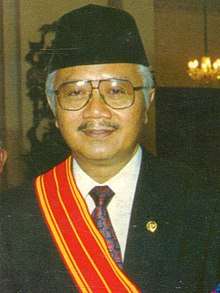1992 Indonesian legislative election
Indonesia's sixth legislative election, and the fifth under the New Order regime, was held on 9 June 1992. Although the share of the vote won by Golkar declined, and the two parties saw their votes rise, the government organisation still won a clear majority.
| |||||||||||||||||||||||||||||||||||||
400 (of 500) seats in the People's Representative Council | |||||||||||||||||||||||||||||||||||||
|---|---|---|---|---|---|---|---|---|---|---|---|---|---|---|---|---|---|---|---|---|---|---|---|---|---|---|---|---|---|---|---|---|---|---|---|---|---|
| Turnout | 95.1% | ||||||||||||||||||||||||||||||||||||
| |||||||||||||||||||||||||||||||||||||
 Results of the local elections showing the party with the largest share of votes. Probolinggo and Pekalongan were the last place where PPP still gains majority.
Golkar PPP PDI | |||||||||||||||||||||||||||||||||||||
| |||||||||||||||||||||||||||||||||||||
 |
|---|
| This article is part of a series on the politics and government of Indonesia |
|
|
Background
In 1973, the government 'obliged' the nine political parties of the time to fuse themselves into the Islamic United Development Party (PPP) and the nationalist Indonesian Democratic Party (PDI). The only other participant for all the elections held during the New Order regime was Golkar, the "functional group".[1]
In the run up to the election, the PPP worked hard to position itself as a party that was not extreme in its outlook, and that was not an opposition force, in an effort to bring about an open and participative political culture in which the party would play a more meaningful political role. Long before the election campaign, the PPP had decided on President Suharto as its presidential candidate for the 1993-1998 term.[2]
Since its 1996 Congress, the PDI had striven to increase party unity and put an end to internal party conflict. It tried to position itself as the party of the "little people" to take advantage of public dissatisfaction. It also tried to portray itself as the most nationalistic party and raised issues such as social inequality and emphasized its anti-foreign aid stance.[3]
Golkar had its share of internal problems, mainly caused by the fact it was a more complex organization than the two political parties, resulting in sometimes poor coordination between the center and the branches in provinces such as Riau, West Kalimantan, and North Sulawesi. It also faced demands for more openness and to respect human rights.[4]
The campaign
Protests and casualties
The election campaign lasted from 10 May to 3 June.[5] On 9 May, Interior Minister and Election Board chairman Rudini stated that all election participants (i.e. the two parties and Golkar) had the same standing, rights and obligations during the campaign.[6]
On 19 May, following widespread violations of traffic laws by election participants, Rudini said that the campaign to date had not been "ideal", and that a good campaign would take the form of political debates, including using the electronic media and the press. The following day, the governor of Yogyakarta banned the use of two-wheeled vehicles for campaigning. Two days later, PPP and PDI members removed their flags from the streets of Yogya and replaced them with white flags as a protest against the ban. The sultan of Yogyakarta and local Golkar chairman Hamengkubuwono, appealed to the PPP and the PDI to reconsider the removal of their flags as it would damage the national and international image of the city. On May 22, around 3,000 students bearing white flags and calling themselves the "white group" marched out of a local university campus. The demonstration ended after representatives were allowed to meet with the chairman of the local legislature. This became known as the "Yogya Incident".[7]
On 26 May, Coordinating Minister for Political and Security Affairs Sudomo said that President Suharto was very concerned about the way the campaign was being conducted and the large number of deaths.[8] On 1 June, an interior ministry official announced that 23 people had died during the campaign, all as a result of traffic accidents. A further 194 had been injured.[9]
Golkar
Golkar's campaign began with a rally in Surabaya, East Java. On 23 May, party spokesman Sarwono Kusumaatmadja said that it was difficult to bring about change without risking the unity of the nation, and that the priority was to build a strong economic basis.[10] According to Golkar spokesman Sudomo, speaking on 29 May, the organization's priorities for the next five years were to improve quality in all aspects by developing human resources, to fight against the excesses of deviations from development such as corruption and legal levies, to build openness and Pancasila democracy together with legal certainty and to persuade Suharto to stand for the presidency for the next five-year term.[11] Golkar's campaign ended where it had begun, in Surabaya,.[12]
United Development Party
At the beginning of the PPP's campaign in Jakarta on 10 May, senior party official Djufrie Asmoredjo again stated that the PPP would nominate Suharto for the presidency, with General Try Sutrisno as his deputy. On the same day, PPP chairman Ismail Hasan Metareum said that the party would work to improve the lot of the disadvantaged by building a pro-people economy and bringing about social justice.[13] On 29 May, he said the PPP must win a majority of the vote in Jakarta, and reminded supporters to vote for the party.[14] Ending the party's campaign in Semarang on 3 June, secretary general Matori Abdul Djalil read a five-part political statement calling on people to use their vote and saying that Pancasila was the only basis for society.[15]
The Indonesian Democratic Party
On 10 May in Surabaya, PDI chairman Soerjadi said the election was a way of preventing authoritarian government, and limiting power. Two days later, he said that although the 1945 Constitution did not impose a limit on the number of presidential terms, the PDI would like to see a two-term limit[16] Several million people attended the PDI's final rally in Jakarta. Soerjadi called for the 1985 law on political parties to be amended to allow the political parties to organizese down to the village level and for an end to the practice of closing down publications. He also demanded tougher sentences for those convicted of corruption and an end to monopolies.[17]
Results

Polls opened at 08:00 local time and closed at 14:00. After counting of votes at the polling stations, results were sent to the central election agency. The results were officially announced on June 29.[18] Of the 107,565,697 registered voters, 90.91% cast valid votes.[19]
| Ballot number | Election participant | Votes | % | Seats |
|---|---|---|---|---|
| 2 | Golkar (Golongan Karya) | 66,599,331 | 68.10 | 282 |
| 1 | United Development Party (Partai Persatuan Pembangunan, PPP) | 16,624,647 | 17.01 | 62 |
| 3 | Indonesian Democratic Party (Partai Demokrasi Indonesia, PDI) | 14,565,556 | 14.89 | 56 |
| Total | 97,789,534 | 100% | 400 | |
| Source: Komisi Pemilihan Umum (General Election Commission), p40 | ||||
Aftermath
In October 1992, Golkar and the two parties began discussions over the agenda for the People's Consultative Assembly the following March at which the president and vice-president would be elected. Demanding changes to the electoral system as well as an end to corruption and abused of power, the PDI refused to nominate its presidential candidate. This was despite the fact the other factions, Golkar, the PPP and the Armed Forces faction had already nominated Suharto. At the conference, which opened on 12 January 1993 Soerjadi came under pressure from demonstrating party members to nominate a candidate other than Suharto, and from the government and military officers to nominate Suharto. Eventually, on 14 January, Soerjadi announced the party had unanimously decided on Suharto. The party also dropped all its demands except for electoral reform. However, these were ignored at the People's Consultative Assembly general session, which opened on from 1 March. Despite three PDI delegates marching to the speaker's podium demanding discussion of their demands, under Golkar and military pressure, they withdrew their demands. Suharto and Try Sutrisno were elected president and vice-president for the 1993-1998 term.[20]
References
- Ricklefs (1991) p276
- Silalahi (1995) p19-20
- Silalahi (1995) p24-25
- Silalahi (1995) p23-24
- Subidjo (1995)
- Subidjo (1995) p173
- Subidjo (1995) p176-177
- Subidjo (1995) p182
- Subidjo (1995) p184
- Subidjo (1995) p196
- Subidjo (1995) p198-199
- Subidjo (1995) p205
- Subidjo (1995) p209
- Subidjo (1995) p213
- Subidjo (1995) p215
- Subidjo (1995) p217
- Subidjo (1995) p222
- Subidjo (1995) p120-121
- Subidjo (1995) p158
- Schwartz (1994) p265-267
Bibliography
- Komisi Pemilihan Umum (General Election Commission) retrieved January 6, 2008
- Liddle, R. William (1994) Pemilu-Pemilu Orde Baru (Elections of the New Order), LP3ES, Jakarta ISBN 979-8015-88-6
- Ricklefs, M.C. (1991). A history of modern Indonesia since c.1200. Stanford: Stanford University Press. ISBN 0-8047-4480-7
- Schwartz, Adam (1994) A Nation in Waiting: Indonesia in the 1990s, Allen & Unwin. ISBN 1-86373-635-2
- Silalahi, Henry Tjan (1995) Evaluasi Pemilihan Umum 1992 in Sudibjo, M (Ed) (1995) Pemilihan Umum 1992: Suatu Evaluasi (The 1992 General Election: An Evaluation) Center for Strategic and International Studies, Jakarta. (ISBN 979-8026-26-X) OCLC 32449151
- Sudibjo, M (Ed) (1995) Pemilihan Umum 1992: Suatu Evaluasi (The 1992 General Election: An Evaluation) Center for Strategic and International Studies, Jakarta (ISBN 979-8026-26-X) OCLC 32449151


